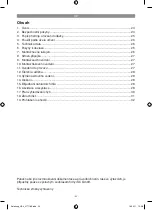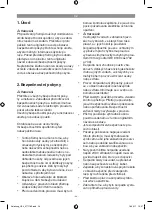
GB
- 9 -
10. Fitting a pressure pipe
•
The discharge line (should be min. 19
mm (3/4“)) must be connected approx.
33 mm to the discharge line connection
(R1 female thread) of the pump either di-
rectly or with the aid of a threaded nipple
(Fig. 1/Item 7).
•
You can also use a pressure hose of ap-
prox. 13 mm (1/2“) with the relevant cou-
plings. The pump rate is reduced when
using the smaller discharge line.
•
During the priming process, the shut-off
devices present in the discharge line
(spray nozzles, valves, etc.) must be
completely open so that the air in the
intake line can escape freely.
11. Starting up
•
Place the pump on a firm and level sur-
face.
•
Before starting the pump, it must be
se-
curely mounted
on the surface using
the holes in the stand (see Fig. 1/Item 3).
•
Fit intake line so that it is ready for use.
•
Fill pump with water at the filler screw
(Fig. 1/Item 6) up to the full point.
•
During the priming process, the shut-off
devices present in the discharge line
(spray nozzles, valves, etc.) must be
completely open so that the air in the
intake line can escape freely.
•
The initial intake process can take ap-
prox. 30 seconds to 5 minutes, depen-
ding on the suction height and volume
of air in the intake line. The pump should
be topped up with water if the priming
time is longer.
•
If the pump is removed after use, it is es-
sential that it is filled with water again the
next time it is connected and started.
•
Establish electrical connection.
12. Cleaning and maintenance
•
The pump is largely maintenance-free.
In order to ensure a long service life,
however, we recommend regular checks
and product care.
Caution!
The pump must be disconnected
from the power supply by removing
the power plug before carrying out
any maintenance.
•
Before lengthy periods of inactivity or
winter storage rinse the pump thorough-
ly, empty it completely and store it in a
dry place.
•
To drain the pump housing, undo the
water drain screw (Fig. 1/Item 4) and tilt
the pump slightly.
•
The pump must be completely emptied
if there is a risk of frost.
•
After relatively long periods of storage,
switch on and off briefly to check whe-
ther the rotor is turning properly.
•
If the pump is clogged, connect the
discharge line to the water line and dis-
connect the intake line. Open the water
line. Switch on the pump several times
for approx. two seconds. This should
resolve the majority of clog-related pro-
blems.
•
We recommend lukewarm water to clean
the motor and pump housing.
13. Replacing the mains cable
Caution!
Disconnect the unit from the power sup-
ply! A defective mains cable may only
be replaced by a qualified electrician.
Anleitung_LB4_4171183.indb 9
16.09.11 10:06










































